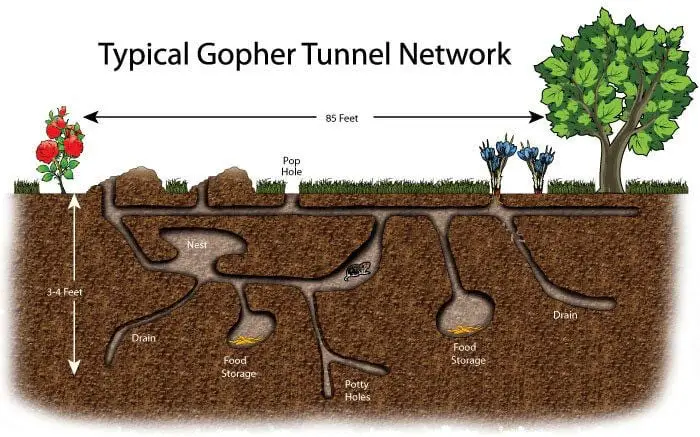When first had a gopher problem in my yard, a friend recommended I fill the gopher holes with cement or concrete. On the face of it, this makes sense. After all, once cement hardens, it should be a barrier for gophers to tunnel through.
However, it’s not that simple and throws up many challenges. There are also some myths as well, about how dry cement can kill gophers. Below I will cover all of this, and then give you what I think are better solutions to the holes in your backyard.
Filling gopher holes with cement is not a good idea
Gophers are devious, cunning, and resourceful. They can create on average one new hole a day in a lawn, which then leads down into an extensive tunnel network.
You might think that to fill a gopher hole with concrete or cement will prevent the critters from causing more damage to your backyard or lawn. But sadly, the opposite is true, and for many different reasons.
The most obvious drawback to filling gopher holes with cement is the damage you are doing to the environment and ecology. This could prevent water draining from your lawn, and also stop lawn growth at the surface.
You should also consider how much cement or concrete is needed to fill gopher holes effectively. If you look at the illustration below, it shows how extensive their tunnels can be.

Also notice the structure… when pouring cement into a gopher hole, it will only go so far before stopping.
Filling gopher hole with concrete is not practical or cost-effective for this reason.
Then there’s the biggest reason why filling gopher holes with cement is pointless: gophers are prolific diggers of holes and tunnels.
If you pour cement or concrete down a gopher hole and it then dries and hardens, what do you think will happen?
Let me explain…
Gophers’ ability to dig through concrete
Gophers cannot bite, chew, or dig through concrete that has set and hardened. Yes, they can dig underneath concrete (such as house foundations), but they cannot dig through and wreck concrete.
What that means is, the gophers will find an alternative route around the cement and concrete.
They will simply dig another tunnel quickly, around the cement you poured into their tunnel, and come up via a different and new hole in your backyard.
If you’ve ever played the game Whac-A-Mole, you will know what to expect.
There are better ways of getting rid of gophers and filling their holes, without resorting to cement and concrete which are not effective. You can read my guide here.
However, if you do want to still try pouring concrete or cement into gopher holes, here’s how to do it.
Simply flush the gopher out first. To do this you might try high pressure water, or castor oil. Providing the tunnels have not collapsed, start pouring the concrete into the open hole.
Make sure you leave a 3-inch gap at the top though. Once the cement has hardened, you can top this gap up with soil, or perhaps place a piece of turf over it to disguise where the hole was filled.
You could also consider then scattering coffee grounds on the lawn, particularly near the holes. This is said to be a deterrent, and I have tested it with mixed results.
It’s still worth a go, though.
Do concrete walls stop gophers?
Concrete walls can stop gophers, providing the foundations are deep enough. Gophers can dig as deep as 6 feet, but this is the exception rather than the rule. Most gophers will only dig down 6 to 12 inches underground.
When putting up a shed on concrete slab can gophers still dig under
Yes, gophers can dig under concrete slabs, and will cause the ground to become uneven and possibly unstable.
More backyard guides…
Image in header via https://pixabay.com/photos/cement-concrete-construction-worker-406822/

